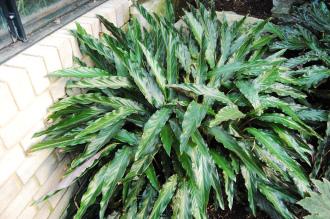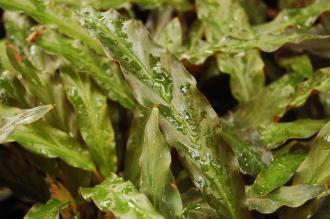
Calathea rufibarba (16/01/2016, Kew Gardens, London)
Position: Bright indirect light to low light
Flowering period: Summer
Soil: Moist, well drained
Eventual Height: 60cm
Eventual Spread: 60cm
Hardiness: 10a, 10b, 11, 12
Family: Marantaceae
Calathea rufibarba is a tropical evergreen perennial with a clump forming habit. Its glossy dark green leaves are red and velvety on their undersides, lanceolate with wavy entire margins, up to 40cm long and 10cm across. Its pale yellow flowers appear on short flower stalks at the base of the plant in dense spikes. Its roots have fleshy rhizomes.
Calathea rufibarba, commonly known as Velvet Calathea or Furry Feather Calathea, is native to South America, including Brazil. In its native habitat it grows as a tropical woodland understory plant.
The etymological root of the binomial name Calathea is derived from the Latin calathus menaing ‘flower basket’, in reference to its flowers. Rufibarba is derived from the Latin rufus menaing ‘red’ and barba meaning ‘beard’, in reference to the undersides of its leaves.
The landscape architect may find Calathea rufibarba useful as an attractive foliage houseplant, suitable for lower light levels.
Ecologically, Calathea rufibarba is of little benefit to UK wildlife.

Calathea rufibarba Leaf (16/01/2016, Kew Gardens, London)
The Royal Horticultural Society have given Calathea rufibarba their prestigious Award of Garden Merit in 2012.
Calathea rufibarba prefers moist, fertile, well-drained soils. It tolerates most pH of soil.
When maintaining Calathea rufibarba as a houseplant its soil should be watered regularly, although the soil should not be wet. Watering should be reduced during the winter months. Its preferred active growing temperature rages from between 16ºc to 24ºc, it will tolerate temperatures as low as 10ºc. Feeding with weak fertiliser solution should be carried out once a month during the growing season. The leaves may be sprayed with water to increase humidity. Red spider Mites, Mealy Bug and Scale Insects may attack this plant.

Landscape Architecture

